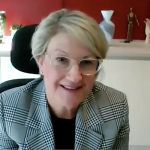How to manage workers wearing masks – the new workplace rules

Communicating with employees and managing difficult or underperforming staff members behind a mask requires new strategies when delivering serious messages.
Workplace behaviour expert Maureen Kyne says having watched workplaces operate with masks over the last year, the employee/employer dynamic has changed and workplaces need to adjust accordingly.
“For the time being, face masks are here to stay,making difficult conversations with staff even more challenging,” says Ms Kyne, from Maureen Kyne & Associates.
“It might seem like a small change but given how much we rely on our faces to communicate; it makes a big difference,” she said.
“Managers will have to work harder; more eye contact, better active listening and even a greater emphasis of body language to compensate for the lack of facial gestures that would normally help managers respond to difficult work situations.
It’s commonly believed that nonverbal communication, such as facial gestures, constitutes 55 per cent of our overall communication.
Ms Kyne says greater emotional accuracy is required in a masked office because nuances can also be lost in communication when facial reactions aren’t visible.
Ms Kyne’s advice on how to communicate better while wearing a mask:
Mask voice: We know masks muffle speech, making it harder to understand conversations and instructions so use a ‘mask voice’ when delivering bad news or managing a stressful work situation. Slower speechwill help increase employee understanding of your message. Enunciate words so they can be heard more clearly. Raising your voice too much can impact the message you’re trying to get across so try and find the right tone to deliver difficult conversations
Quiet room: There is a loudness perception when the face is covered so a room offering greater privacy will help diffuse potential tensions that may arise in a meeting. When having difficult conversations with staff members be aware of surrounding sound that may make it hard to understand what you’re saying. We instinctively increase the volume of our voice when our mouth and nose is concealed.
Language: Information conveyed to employees may get lost in translation. Use simple, short and clear sentences and tactfully repeat key words and phrases. Ask for clarification from your employee to make sure they understood the directives and repeat what you have said to convey emotion and empathy. Avoid sarcasm and humour – it may not be received well in a muffled voice.
Meeting checklist: Not being able to read facial expressions can be disconcerting. It can make staff more nervous or on edge when attending meetings. People react in different ways when given news about their redundancyor a performance review so it’s important staff are aware of the purpose of the meeting and possible outcomes. With no ability to hug or handshake, it’s important to ask them I how they feel about what has taken place.
Don’t put off difficult conversations: Disruptive, unproductive and poor-performing workers impact on workflow and teams. Masks should not deter managers from addressing these issues. Difficult behaviours affect morale and your workplace so fix the problem with a mask on rather than waiting for the mask rule to be lifted and the toxic behaviour to cause further damage.
Ms Kyne warns that in these trying times when masks are being worn to help protect everyone from spreading infection, there is a risk interactions may be misunderstood.
“Working with people is about relationships and we don’t have that at the moment. So there is also a risk to mental health.”
“Anticipating the problems and challenges involved in delivering performance reviews or managing conflict in a meeting when masked up is vital when diffusing potentially hostile work situations.”
“Providing feedback effectively involves facial expressions and body language but now the key to delivering feedback lies in being coherent, respectful and tactful.”
In times like this Ms Kyne says companies need to raise awareness on the use of face masks and acknowledging the communication challenges that arise as a result.
Maureen Kyne is the principal of Maureen Kyne & Associates and is a workplace bullying, sexual harassment and discrimination specialist. She works with C-Suite and senior leadership teams across manufacturing, healthcare and local government sectors. She has over 20 years’ experience consulting businesses in HR, IR & WHS.








